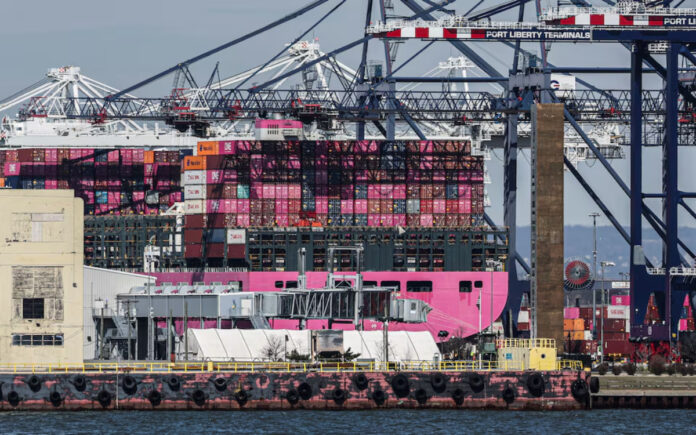Washington: U.S. customs authorities have begun collecting the 10% blanket tariff ordered by former President Donald Trump, marking a fundamental shift in the country’s trade policy. The levy took effect early Saturday at 12:01 a.m. ET across all major entry points, including seaports, airports, and customs warehouses. It applies to imports from dozens of countries, with steeper tariffs on goods from 57 major trading partners expected to follow in the coming week.
This sweeping measure signifies a definitive break from the post-World War II consensus of negotiated tariff regimes and multilateral cooperation. It ushers in a new era of unilateral economic policy—one that Trump’s allies say restores fairness, while critics argue it threatens global stability.
“This is the single biggest trade action of our lifetime,” said Kelly Ann Shaw, a trade attorney at Hogan Lovells and former White House trade adviser. Speaking at a Brookings Institution event on Thursday, Shaw added, “This is a pretty seismic and significant shift in the way that we trade with every country on earth,” noting the potential for these tariffs to evolve as nations seek exemptions or concessions.
Markets reacted sharply to Trump’s announcement on Wednesday, with global equities losing $5 trillion in value by the close of trading on Friday. The S&P 500 posted its steepest two-day drop on record, while oil and commodity prices plummeted amid recession fears. Investors sought refuge in U.S. Treasuries, signaling uncertainty over the long-term consequences of the policy.
Despite maintaining trade surpluses with the U.S., countries such as Australia, the United Kingdom, Brazil, Colombia, Argentina, and Saudi Arabia were among the first to be hit with the 10% tariff. White House officials argue that many of these countries would show larger U.S. deficits if their trade practices were more balanced.
A bulletin from U.S. Customs and Border Protection offered a temporary reprieve: shipments that were already in transit or loaded before the deadline will be exempt from the new tariffs if they arrive before May 27—a 51-day grace period.
'This is an economic revolution,' Trump said on social media as US customs agents began collecting a unilateral 10% tariff on all imports from countries, including Australia, Britain, Colombia, Argentina, Egypt and Saudi Arabia https://t.co/pbgWMv0s89 pic.twitter.com/xAo5aHxvlY
— Reuters (@Reuters) April 6, 2025
The more aggressive phase of Trump’s plan will begin on Wednesday, when “reciprocal” tariffs ranging from 11% to 50% are set to go into effect. European Union imports will face a 20% duty, while Chinese goods will be subject to a combined 54% levy after an additional 34% is applied.
In response, Beijing unveiled its own countermeasures. “The market has spoken,” Chinese officials said Saturday, dismissing the U.S. move. China responded with tariffs of its own—34% on all U.S. goods—and imposed new export restrictions on strategic rare earth minerals.
“China has been hit much harder than the USA, not even close,” Trump declared on social media. “THIS IS AN ECONOMIC REVOLUTION, AND WE WILL WIN. HANG TOUGH, it won’t be easy, but the end result will be historic.” He was later seen at his golf club in Jupiter, Florida, reviewing coverage of China’s retaliation and the resulting financial fallout.
Global Responses and Strategic Talks
The international backlash has been swift. French President Emmanuel Macron warned, “A trade war is in no one’s interest. We must stand united and resolute to protect our citizens and our businesses,” in a post on X.
British Prime Minister Keir Starmer, writing in the Telegraph, signaled an openness to industrial policy as a buffer against the disruption, while expressing a desire to negotiate a U.S.-U.K. trade deal that may secure tariff exemptions.
Israeli Prime Minister Benjamin Netanyahu is scheduled to travel to Washington on Sunday to address the 17% tariff on Israeli exports. Meanwhile, Japanese Prime Minister Shigeru Ishiba is reportedly seeking direct contact with Trump over a 24% levy imposed on Japanese goods.
Also Read | France-Algeria Relations Strained by Trade, History, and Security Disputes
Vietnam, which has benefited in recent years from a shift in U.S. supply chains away from China, responded swiftly to the announcement of a 46% tariff on its exports, agreeing to discuss a trade arrangement with Washington.
Taiwan, also impacted by a 32% duty, began high-level internal discussions on Saturday. President Lai Ching-te convened with major technology executives to evaluate the possible ramifications and counterstrategies.
Italian Economy Minister Giancarlo Giorgetti cautioned against retaliatory tariffs on the United States, warning at a Milan forum that such actions could escalate tensions and hurt both sides.
Also Read | Social Security at Risk? Americans March Against Trump’s Restructuring Plan
In a notable comment, U.S. billionaire Elon Musk addressed a political conference in Italy via video link, expressing his hope for “complete freedom of trade between the United States and Europe,” which he described as “a zero tariff situation.”
Canada and Mexico were notably exempted from the new wave of tariffs, though both countries remain subject to a previously announced 25% tariff for failing to meet the rules-of-origin criteria under the updated North American trade pact.
Although Trump’s executive order carved out exemptions for over 1,000 product categories—including pharmaceuticals, uranium, and semiconductors—the administration has indicated that some of these products may face future duties as the policy continues to evolve.



